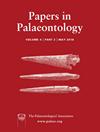Radiolarian response to environmental changes at the Sinemurian–Pliensbachian transition in the Northern Calcareous Alps, Austria
IF 2.2
2区 地球科学
Q1 PALEONTOLOGY
引用次数: 0
Abstract
Major environmental, climate and sealevel changes occurred in the Western Tethyan Realm during the late Sinemurian to early Pliensbachian time interval. Here, we examine how these changes affected the taxonomic composition of radiolarian fauna. Radiolarian assemblages were collected on Mount Rettenstein (Northern Calcareous Alps) from a siliceous limestone and marl succession, deposited in a well‐oxygenated basin a few hundred metres in depth on the continental shelf at the western edge of the Neotethys Ocean. Radiolarian research was complemented with elemental and isotope geochemistry on bulk carbonate samples. The siliceous microfaunas below and above the stage boundary consist of more than 80% sponge spicules and less than 20% radiolarians, with a strong predominance of the Order Spumellaria. The Nassellaria to Spumellaria abundance ratio ranges from 1:5 to 1:3. At the Sinemurian–Pliensbachian transition, a significant drop in diversity occurred, accompanied by a substantial change in relative abundances of radiolarian taxa. The most severely affected groups were surface‐dwelling radiolarians (Angulobrachiidae, Hagiastridae, Pantanelliidae; mostly奥地利北钙质阿尔卑斯山新元古代-渐新巴赫过渡时期放射虫对环境变化的反应
在新元古代晚期到上元古代早期,西哲罗纪发生了重大的环境、气候和海平面变化。在此,我们研究了这些变化如何影响放射虫动物群的分类组成。我们在雷滕斯坦山(北钙质阿尔卑斯山)的硅质石灰岩和泥灰岩演替中采集了放射虫组合,该演替沉积在新特提斯洋西部边缘大陆架几百米深的高氧盆地中。在对放射虫进行研究的同时,还对大量碳酸盐样本进行了元素和同位素地球化学研究。阶段边界以下和以上的硅质微浮游生物由 80% 以上的海绵纤毛虫和不到 20% 的放射虫组成,其中以 Spumellaria 纲为主。Nassellaria 与 Spumellaria 的丰度比从 1:5 到 1:3 不等。在新元古代-上新世过渡时期,生物多样性显著下降,同时放射虫类群的相对丰度也发生了巨大变化。受影响最严重的类群是表栖放射虫(Angulobrachiidae、Hagiastridae、Pantanelliidae;主要是 Gorgansium、Poulpidae 和 Ultranaporidae),它们几乎或完全消失了。与此相反,Archaeocenosphaera、Praeconocaryomma、Zhamoidellum 和 Lantus 的数量增加,显然它们对环境压力的抵抗力最强。放射虫群落的变化是局部性的,可能是由新元古代末期海平面下降引起的,海平面下降使该地区变成了一个海洋环流受限的半封闭盆地。与公海的水团交换减少了,因此放射虫动物群落也减少了,其生产力也可能因海洋肥沃水流的减少而降低。
本文章由计算机程序翻译,如有差异,请以英文原文为准。
求助全文
约1分钟内获得全文
求助全文
来源期刊

Papers in Palaeontology
PALEONTOLOGY-
CiteScore
4.50
自引率
4.30%
发文量
55
期刊介绍:
Papers in Palaeontology is the successor to Special Papers in Palaeontology and a journal of the Palaeontological Association (www.palass.org). The journal is devoted to the publication of papers that document the diversity of past life and its distribution in time and space.
Papers in Palaeontology is devoted to the publication of papers that document the diversity of past life and its distribution in time and space. As a sister publication to Palaeontology its focus is on descriptive research, including the descriptions of new taxa, systematic revisions of higher taxa, detailed biostratigraphical and biogeographical documentation, and descriptions of floras and faunas from specific localities or regions. Most contributions are expected to be less than 30 pp long but longer contributions will be considered if the material merits it, including single topic parts.
The journal publishes a wide variety of papers on palaeontological topics covering:
palaeozoology,
palaeobotany,
systematic studies,
palaeoecology,
micropalaeontology,
palaeobiogeography,
functional morphology,
stratigraphy,
taxonomy,
taphonomy,
palaeoenvironmental reconstruction,
palaeoclimate analysis,
biomineralization studies.
 求助内容:
求助内容: 应助结果提醒方式:
应助结果提醒方式:


